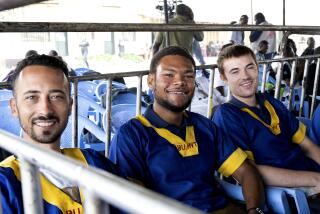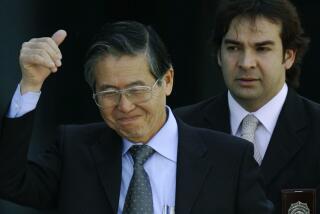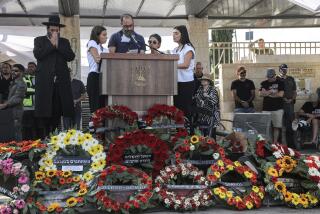Commandos Free Peru Captives : One Hostage, All Rebels Killed in Risky Raid
BUENOS AIRES — Peruvian commandos Tuesday stormed the Japanese ambassador’s residence in Lima, where leftist rebels were holding 72 captives, ending Latin America’s longest such standoff with a daring daylight attack that liberated 71 hostages and left one hostage dead, along with two soldiers and all the rebels.
The raid by 140 commandos was launched at 3:20 p.m. As explosions sent up clouds of smoke and masked soldiers charged into the barricaded mansion firing their weapons, commandos rushed dazed-looking hostages--wearing sweatsuits and shorts, their faces bloodied--out of a roof-level exit, down a side stairway and out of the compound to waiting ambulances.
Among the freed hostages was the slightly injured Japanese ambassador, Morihisa Aoki, who entered an ambulance under his own power and was at his office working within two hours. The Peruvian foreign minister, Francisco Tudela, who was wounded in an ankle, pumped a fist in the air victoriously as soldiers carried him away on a stretcher.
The military raiders killed all 14 guerrillas of the Tupac Amaru Revolutionary Movement during the 40-minute gunfight, President Alberto Fujimori told reporters.
“There was no other way out,” Fujimori said, despite his repeated vow not to use force against the rebels unless they harmed hostages.
The president identified the dead hostage as Supreme Court Justice Carlos Giusti. His voice breaking during a speech to the nation delivered from the back of a pickup truck at the scene, Fujimori said the two dead soldiers were Lt. Raul Jiminez and Cmdr. Juan Valdez, commandos who served as bodyguards for the president’s son, Kenji.
About 26 hostages suffered wounds, all minor except in the case of one man whose life was nevertheless in no danger, said Fujimori. The president’s brother, who was among the hostages, also survived the ordeal.
“Gentlemen, in Peru we are not going to accept terrorism,” Fujimori shouted. “In Peru, we are going to strengthen the principles of democracy. We have given an example to the international community that you cannot permit terrorist blackmail, you must not surrender.”
Minutes after the shooting had stopped, Fujimori strode into the diplomatic-compound-turned-battlefield wearing a black, bulletproof vest over a white dress shirt and surrounded by commandos with masks and painted faces.
In a dramatic scene on the front steps of the mansion that was televised around the world, Fujimori congratulated the assembled hostages and cheering soldiers, who brandished their weapons in triumph, sang military hymns and tore down the flag the rebels had affixed to the roof.
The guerrillas took over the compound during an elegant reception Dec. 17, capturing hundreds of elite international hostages and demanding that the Fujimori government release imprisoned Tupac Amaru comrades.
The rebels gradually released most of their captives, including a group of American diplomats, early in the siege. There were no Americans in the compound Tuesday.
The raid that ended the four-month siege appeared to be “an almost total triumph,” said Peruvian sociologist Raul Gonzalez, an expert on terrorism.
The attack apparently caught the rebels by surprise. It came soon after the hostages had finished lunch and less than two hours after a regularly scheduled visit to the mansion by Ambassador Anthony Vincent of Canada, one of the negotiators who had shuttled back and forth between the two sides for months.
Most of the hostages were reportedly on the second floor at the time of the raid, with the guerrillas on the first floor playing their customary afternoon soccer game. Soccer was one of the many games and exercises that rebels and hostages used to while away the time. Most of the rebels were jungle-trained youths in their teens and twenties.
“You pick the best time for maximum surprise,” a foreign diplomat monitoring the crisis said. “The middle of the afternoon might not seem the best time, but actually it worked out to be a pretty good time.”
The commandos swarmed the mansion from residences behind it, using explosives to blow through doors and windows, diplomatic sources said.
One of the first explosions blew open access to the floor where the guerrillas were playing soccer, according to an account by one of the released hostages.
Other commandos entered from the roof. Another team reportedly charged in through several tunnels dug by security forces--tunneling denounced to the press last month by Nestor Cerpa Cartolini, the veteran Tupac Amaru leader who died in the gunfight Tuesday after surviving a decade of terrorist acts and confrontations with security forces.
“The operation was designed so that there would be no victims,” Fujimori said, expressing his condolences to the family of the slain Supreme Court justice. “Unfortunately, there was one victim.”
Peruvian commandos had been practicing for the operation at a mock-up of the mansion on the outskirts of Lima since December. The operation Tuesday benefited from intelligence about activity inside the mansion that was gathered by Peruvian security forces, which wield great power in Peru and had been lobbying for an attack.
“The intelligence services acted with great efficiency,” Fujimori said in describing the security forces as heroes. “The information was so precise . . . that I did not hesitate for even a second in giving the order for this rescue operation.”
In addition to the accounts of former hostages, Peruvian intelligence services with technical assistance from U.S. agents were using long-range eavesdropping equipment to monitor the movements of the guerrillas inside, according to a diplomatic source.
But U.S. diplomats in Washington stressed Tuesday that there was no American involvement in the raid and no official notification by the Peruvian government ahead of time.
“We received no official warning from the Peruvian government as such, but there were some indications that something might be imminent,” Defense Secretary William S. Cohen told CNN.
He said the Pentagon had picked up some indications of increased military activity moments before the operation began.
He hinted that the United States provided some limited assistance to the Peruvian government, but he declined to be specific.
Other officials said the guerrillas were primarily responsible for the bloodshed even though most of the blood turned out to be theirs.
“One thing is clear: The [guerrillas] bear the full and complete responsibility for this outcome,” State Department spokesman Nicholas Burns said.
Fujimori’s government had shown patience and responsibility and did not act until all peaceful means had been exhausted, the officials said.
“I believe they acted responsibly,” Cohen said. “In other cases, we’ve seen actions taken by governments that were precipitous, resulting in loss of life of both the hostages and those who were taking them hostage. In this particular case, I think that the Peruvian government acted with great restraint.”
Despite Fujimori’s reputation for toughness, there had been widespread doubt that he would order a raid because of the adamant opposition to violence expressed by the Japanese government.
Japan is a major donor of foreign aid to Peru and has close political and cultural ties to Fujimori, the son of Japanese immigrants.
The first Japanese reaction to the raid came at an early morning news conference in Tokyo held by Prime Minister Ryutaro Hashimoto.
He said the Japanese government had not been informed in advance of the plan to storm the ambassador’s residence and received a phone call just before 5:30 a.m. Tokyo time informing him that a rescue attempt had begun.
Hashimoto termed it “regrettable” that Japan was not consulted or informed in advance, but expressed his thanks to the Peruvian government for securing the safe release of all the Japanese hostages.
“Our country was not informed in advance of the rescue attempt,” Hashimoto said. “I must say I think this is regrettable. However, I must express my heartfelt thanks to President Fujimori and the other in the Peruvian government for seizing the chance and carrying out a splendid rescue.”
Hashimoto extended his condolences to the families of the slain soldiers.
He said Japanese Foreign Minister Yukihiko Ikeda is leaving for Lima today. NHK television reported that the Japanese government was not alone in being kept out of the loop; the rescue plan was known only to a tiny number of people within the Peruvian government.
Families of the hostages greeted the release with joy.
“It’s wonderful,” said Kimie Toda. Her son, Toyoaki Toda of Matsushita Electric, was released by the guerrillas in January but returned to Lima in February to keep a vigil outside the residence where the company’s president, Shigeru Taki, continued to be held captive.
“Thank goodness everybody held on,” she said. “I am relieved at last.”
Initial reaction from Japanese analysts indicated that although the hostage release has saved Hashimoto from a potential political disaster, the Japanese government is likely to face a renewed spate of criticism for its weakness in crisis management.
“The Japanese government left everything in the hands of the Peruvian government,” said Masatake Takahashi, an independent foreign policy analyst.
For his part, Fujimori said he did not inform the Japanese prime minister because of the need for absolute secrecy. The decision for the rescue operation came more than a month after direct talks between the government and the Tupac Amaru had broken down.
During recent weeks, a three-member commission had been going fruitlessly back and forth between the two sides, trying to hammer out a compromise to win release of the hostages.
The hostages included diplomats, executives, legislators, judges and military and police commanders, mostly middle-aged and elderly men.
The rebels had stuck intransigently to their demand for the release of imprisoned comrades, who number about 380.
Most recently, Cerpa had proposed a list of 20 guerrillas to be released, Fujimori said in his address outside the compound.
“Because The Tupac Amaru took a very hard line, my government took certain decisions,” Fujimori said. “My government decided to remain firm and patient and exhaust all other options.”
Times staff writers Sonni Efron in Tokyo and Norman Kempster and Elizabeth Shogren in Washington contributed to this report.
More to Read
Sign up for Essential California
The most important California stories and recommendations in your inbox every morning.
You may occasionally receive promotional content from the Los Angeles Times.










